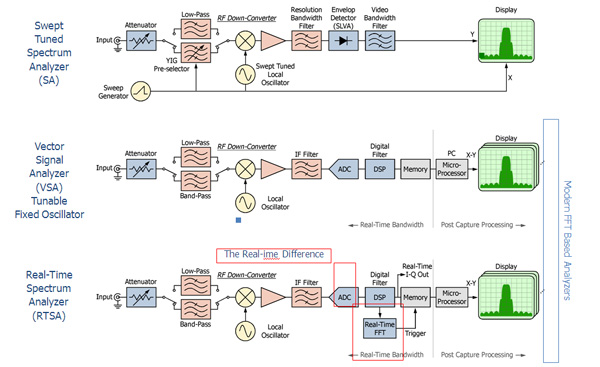This started out as a simple explanation, but before long I realized that it was better to separate my thoughts into a couple of different posts. This all started from the question: “what’s the difference was between swept and stepped spectrum analyzers”. Then, as I started to think about the difference, out came the important figures of merit to consider depending on how you want to use them.
This is Part 1 of 3.
There are two basic architectures of spectrum analyzers, swept and stepped. The later is often referred to as a Signal Analyzer, Vector Signal Analyzer Receiver, or in some cases a Real-time Signal Analyzer.
Both architectures have been around for decades, and evolved to improve upon their function and overcome any limitations. Originally, the swept analyzer was the king of speed and fidelity. This lead to the establishment of the first two banner specifications to consider in the selection of the spectrum analyzer: speed and dynamic range.
However, modern stepped analyzers have now been improved to match or exceed the performance of swept analyzers in both speed and dynamic range, especially when considering broad sweeps of low level signals in the noise …..spur searching. The modern stepped analyzer is now 10’s to 100’s of times faster than the best swept analyzer even with the most sophisticated noise cancelation techniques and DSP enhancements.

Figure 1 – Different architectures of spectrum analyzers
The Swept Spectrum Analyzer
The swept-tuned, superheterodyne spectrum analyzer makespower vs. frequency measurements by downconverting thesignal of interest and sweeping it through the passband of aresolution bandwidth (RBW) filter. The RBW filter is followed
by a detector that calculates the amplitude at each frequencypoint in the selected span. The RBW filter also limits the effective capture bandwidth of the signal that can be instantaneously observed. While this method can providehigh dynamic range, its disadvantage is that it can onlycalculate the amplitude data for one frequency point within the capture bandwidth at atime. This approach is based on the assumption that the
analyzer can complete at least one sweep without therebeing significant changes to the signal being measured and the bandwidth of the signal of interest is entirely within the RBW filter bandwidth.
Consequently, measurements are only valid for relativelystable, unchanging input signals. If there are rapid changesin the signal, it is statistically likely that some changeswill be missed. Broadband pulse signals and impulse noise will be completely misrepresented by the displayed results, and try to capture the presence of wireless LAN or Bluetooth signals using a swept spectrum analyzer.
In the next post, I am going to discuss the details of the different Stepped Spectrum Analyzers, and introduce some additional figures of merit.

